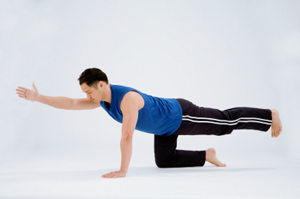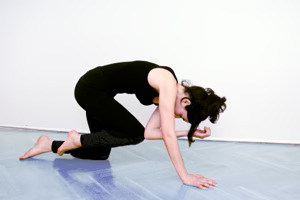How to Do Balancing Table Knee-to-Nose in Yoga
Benefits of Balancing Table Knee-to-Nose
This sequence stretches the spine, shoulders, hips, and hamstrings, while gently opening the sides of the torso and the intercostal muscles (between the ribs). It builds strength throughout the abdomen and lower back. This sequence also improves balance and full-body coordination, while developing a greater ability to focus and concentrate. By synchronizing the breath with movement, this sequence also helps to reduce stress, fatigue, and anxiety, as it energizes and rejuvenates the body and mind.
The breath arises out of stillness, expands, condenses, and returns to this ground of stillness. Oscillation is an intrinsic part of life and all movements.
Cautions
Do not practice this pose if you have a recent or chronic injury to the knees, neck, back, arms, wrists, or shoulders. Always work within your own range of limits and abilities. If you have any medical concerns, talk with your doctor before practicing yoga.
Instructions


- Begin on your hands and knees. Keep your hands directly under your shoulders and your knees directly under your hips. Un-tuck your toes so the tops of your feet are pressing against the floor. The fold of your wrists should be parallel to the top edge of your mat. This is Table Pose.
- Gaze at a point between your palms.
- Draw your belly button toward your spine without arching your back. Then extend your right leg behind you. Tuck your toes and keep them resting on the mat. Press back through the ball of your foot to lengthen your leg. Keep your spine neutral.
- With your abdominal muscles engaged, extend your left arm forward to shoulder-height and reach through your fingertips. At the same time, lift and extend your right leg off the floor, a few inches or all the way to hip-level. Do not lift your leg higher than shoulder-level. This is Balancing Table Pose.
- On an exhalation, draw your right knee in toward your nose as you round through your spine and tuck your chin. At the same time, bring your left elbow toward your right knee.
- Inhale as you extend your left arm and right leg once again.
- Repeat this sequence up to 10 times.
- Exhale and release back to Table Pose on your hands and knees.
- Repeat on the other side, extending your right arm and left leg. Repeat the sequence the same number of times, then release back to Table Pose. Come to rest in Child's Pose (Balasana).
Modifications & Variations
Balancing Table Knee-to-Nose is a great core-strengthening sequence for yoga students of all levels. There should be very little discomfort and no pain when practiced. To find a variation of the pose that works for you, try one of these modifications:
- If your kneecaps hurt, fold your mat or place a firm blanket under your knees.
- For a greater balance challenge, lift your right arm and right leg, while making sure not to lean your body toward the left. Keep your abdominals engaged and your spine neutral (flat). Slowly draw your right knee in toward your nose as you pull your right elbow in toward your right knee. Then repeat with the left arm and left leg.
Tips
Practicing Balancing Table Knee-to-Nose will help warm your body and prepare it for deeper yoga poses. Keep the following information in mind when practicing this sequence:
- Keep your spine in a neutral position when you are in Balancing Table Pose. Do not let your belly drop, as this can over-arch your lower back and cause injury.
- Round your spine when you draw your knee and elbow in. Tuck your chin and tailbone as you draw your belly button toward your spine.
- Hug your body in toward its midline (the vertical line that runs directly through the center of your head, neck, and torso).
- Spread the fingers of your bottom hand and press down through your knuckles.
- Be aware of your breath and its coordination with your movements. Breathe smoothly and evenly throughout the practice.
Build Your Core
Coordinating your breath and your movements in sequences such as Balancing Table Knee-to-Nose builds grace and poise that will stay with you even outside of yoga class. Focusing in order to hold your balance will also help calm your mind. This sequence will stretch and strengthen your whole body, and reduce your everyday stress!

